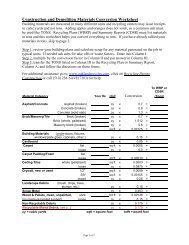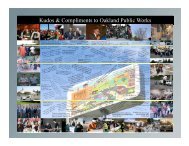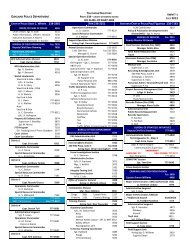Intelligent Transportation Systems - City of Oakland
Intelligent Transportation Systems - City of Oakland
Intelligent Transportation Systems - City of Oakland
Create successful ePaper yourself
Turn your PDF publications into a flip-book with our unique Google optimized e-Paper software.
enefit <strong>of</strong> worldwide standards to standardize the equipment. SONET provides both a<br />
usable standard for ITS and a recent example <strong>of</strong> a successful standards process.<br />
SONET currently provides standards for a number <strong>of</strong> line rates approaching 20 Gbps.<br />
SONET is considered to be the foundation for the physical layer <strong>of</strong> the broadband<br />
Integrated Services Digital Network (ISDN)..<br />
Asynchronous Transfer Mode (ATM) runs as a layer on top <strong>of</strong> the SONET transport for<br />
communicating over a fiber optic medium, so some <strong>of</strong> the SONET bandwidth can be<br />
used for interconnecting ATM nodes together and the remaining SONET bandwidth can<br />
be used for high quality video node equipment.<br />
6.4.1.2 Gigabit Ethernet (GigE)<br />
Although 100Base-T has captured the market for servers and PCs within the LANs, it<br />
does not provide enough bandwidth for today’s typical backbone or wide area network<br />
(WAN) needs. In order to rectify this problem, the 1000Base-T (Gigabit Ethernet)<br />
standard (802.3z) was ratified by the IEEE 802.3 Committee in 1998. This latest 1000<br />
Mbps Ethernet standard is gaining momentum as the backbone technology <strong>of</strong> choice<br />
due to the lower cost associated with Ethernet and the availability <strong>of</strong> products that<br />
support distances in excess <strong>of</strong> 50 km (~30 miles) via Single Mode Fiber Optic (SMFO)<br />
cable. As 1000/100/10 auto-sensing products become widely available, it is anticipated<br />
that GigE will move down to the server and PC side <strong>of</strong> the LAN in the same manner as<br />
the 100Base-T (FAST Ethernet) migration path <strong>of</strong> existing 10Base-T LANs.<br />
6.4.2 Communications Topology<br />
When dealing with the agency-owned alternative (fiber or wireless) communication<br />
infrastructure, there are three primary communication topologies to consider: point-topoint<br />
(star), daisy-chain, and ring. Point-to-point topologies dedicate a communication<br />
path between two points (in this case the field device and the hub). A daisy-chain link<br />
has multiple field devices sharing the communication medium with a single path back to<br />
the node. The ring topology also shares the communication medium with several<br />
devices but has two communication paths to the hub, reducing the effects <strong>of</strong> a single<br />
communication failure. The ring topology is more robust (fault-tolerant) relative to pointto-point<br />
and daisy-chain topologies.<br />
A diagram <strong>of</strong> each topology is shown in Figure 6.1.<br />
<strong>City</strong> <strong>of</strong> <strong>Oakland</strong> ITS Strategic Plan<br />
68 September, 2003
















